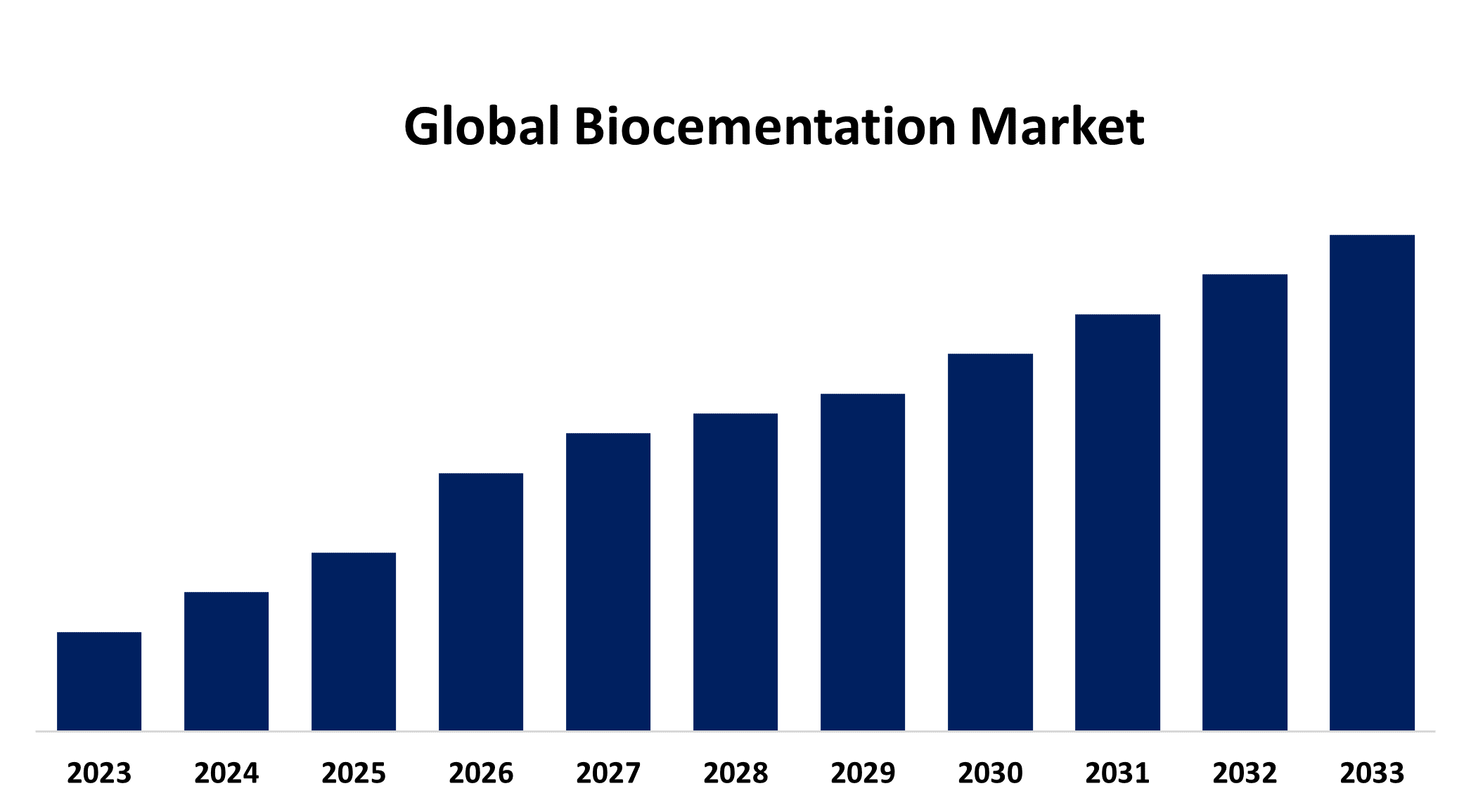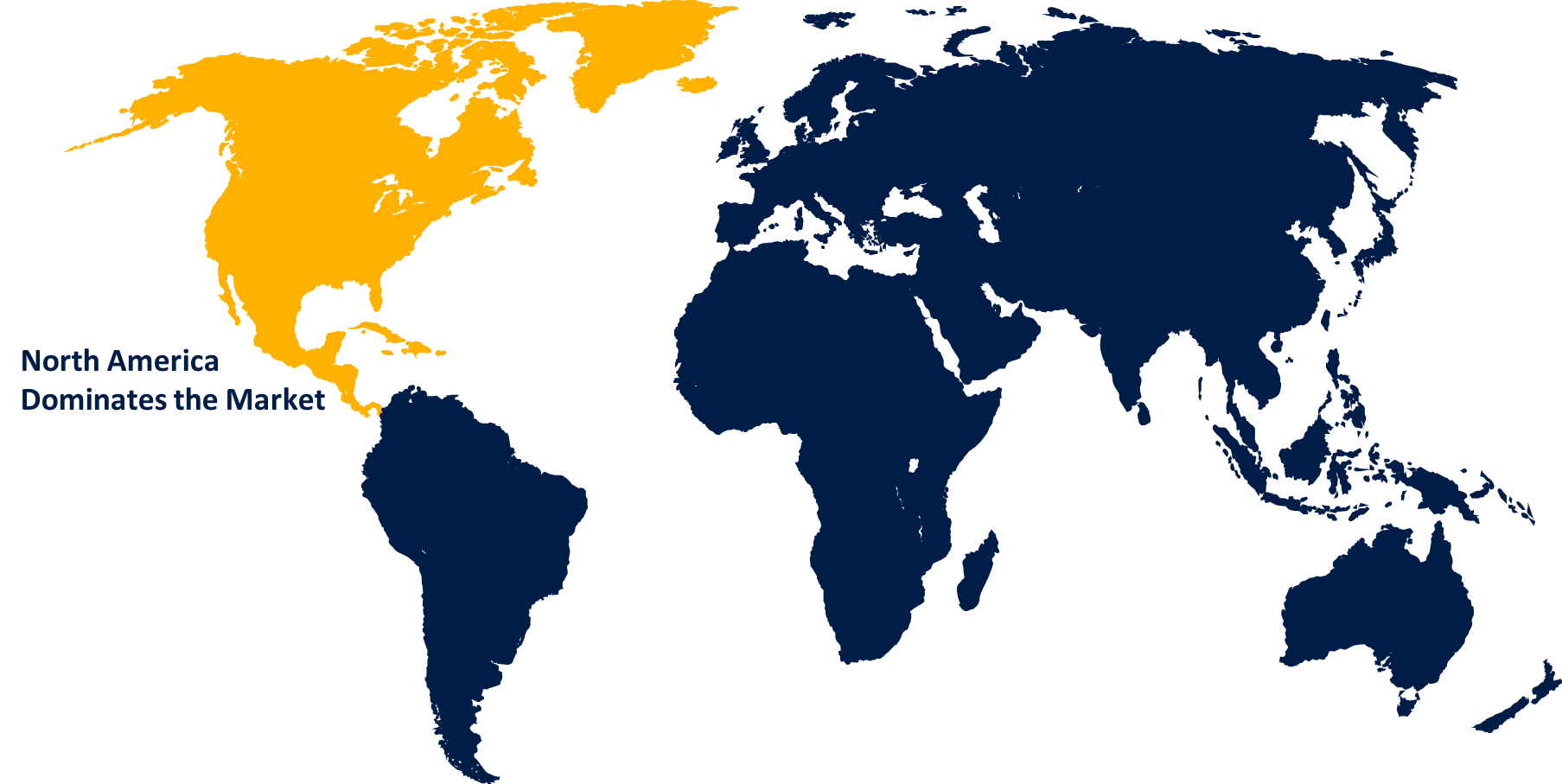Global Biocementation Market Size, Share, and COVID-19 Impact Analysis, By Type (Microbial Induced Calcite Precipitation (MICP), Microbial Induced Carbonate Precipitation (MICP), Bio-Concrete), By Application (Construction, Environmental Engineering, Agriculture, Mining and Oil & Gas), and By Region (North America, Europe, Asia-Pacific, Latin America, Middle East, and Africa), Analysis and Forecast 2023 - 2033tion Market
Industry: Construction & ManufacturingGlobal Biocementation Market Insights Forecasts to 2033
- The Market Size is Growing at a CAGR of 5.9% from 2023 to 2033
- The Worldwide Biocementation Market Size is Anticipated to Hold a Significant Share by 2033
- Asia Pacific is Expected to Grow the fastest during the forecast period.

Get more details on this report -
The Global Biocementation Market Size is Anticipated to Hold a Significant Share by 2033, at 5.9% CAGR from 2023 to 2033.
Market Overview
Biocementation is a process that uses biological agents to improve the properties of soil or other materials, making them more stable and durable. Biocementation is a technology that uses biological processes to improve the characteristics of soil and rocks by precipitating minerals such as calcium carbonate. One common method is the microbial-induced calcite precipitation (MICP) process, which enhances soil stability, reduces erosion, and repairs damaged structures. This eco-friendly technique is used in construction, civil engineering, and environmental remediation. The biocementation approach is utilized in a wide range of applications, including soil stability for buildings, groundwater cleanup by limiting contamination spread, and erosion management to avoid soil loss.
Report Coverage
This research report categorizes the market for biocementation based on various segments and regions forecasts revenue growth and analyzes trends in each submarket. The report analyses the key growth drivers, opportunities, and challenges influencing the biocementation market. Recent market developments and competitive strategies such as expansion, product launch, development, partnership, merger, and acquisition have been included to draw the competitive landscape in the market. The report strategically identifies and profiles the key market players and analyses their core competencies in each sub-segment of the biocementation market.
Global Biocementation Market Report Coverage
| Report Coverage | Details |
|---|---|
| Base Year: | 2023 |
| Forecast Period: | 2023-2033 |
| Forecast Period CAGR 2023-2033 : | 5.9% |
| Historical Data for: | 2019-2022 |
| No. of Pages: | 218 |
| Tables, Charts & Figures: | 110 |
| Segments covered: | By Type, By Application, By Region |
| Companies covered:: | Biomason, BASF SE, The Dow Chemical Company, Acciona Infraestructureas S.A., Fescon, BioCement Technologies Basilisk, Halliburton Technology India Private Limited, Avecom N.V., Comercializadora Espanola De Innovaciones Y Materiales, COWI A/S, Devan-Micropolis, BIOCHEM LTD, and Others Key Vendors. |
| Pitfalls & Challenges: | COVID-19 Empact,Challenges, Future, Growth, & Analysis |
Get more details on this report -
Driving Factors
The biocementation market is propelled by several factors emphasizing sustainability and technological advancement. The growing environmental concerns and the push for eco-friendly solutions are key drivers, as biocementation offers a greener alternative to traditional construction methods by reducing carbon footprints and managing waste. Additionally, the rising demand for sustainable construction practices and infrastructure development, coupled with the benefits of cost efficiency and improved material durability, has driven the market growth worldwide.
Restraining Factors
The biocementation market propelled due to high initial costs for technology setup and specialized equipment can be a significant barrier, particularly in regions with limited resources. Technical challenges, such as ensuring consistent quality and scaling up from laboratory to field applications, add to the complexity. Additionally, the availability and cost of raw materials, competition from established construction methods, and sensitivity to environmental conditions pose further obstacles.
Market Segmentation
The biocementation market share is classified into type and application.
- The microbial-induced calcite precipitation (MICP) segment is estimated to hold the highest market revenue share through the projected period.
Based on the type, the biocementation market is classified into microbial-induced calcite precipitation (MICP), microbial-induced carbonate precipitation (MICP), bio-grouting, and bio-concrete. Among these, the microbial-induced calcite precipitation (MICP) segment is estimated to hold the highest market revenue share through the projected period. Biocementation technology, which involves using microbes to precipitate calcite (calcium carbonate) and stabilize soil, is well-supported by extensive research and practical implementation. Its maturity and cost-effectiveness, coupled with its broad use in soil stabilization, foundation reinforcement, and erosion control, contribute to its dominant position in the market.
- The construction segment is anticipated to hold the largest market share through the forecast period.
Based on the application, the biocementation market is divided into construction, environmental engineering, agriculture, mining and oil & gas. Among these, the construction segment is anticipated to hold the largest market share through the forecast period. The construction segment is propelled by its wide range of applications and growing demand for sustainable building materials. Biocementation, which involves using biological processes to improve soil and enhance construction materials, offers eco-friendly alternatives to traditional methods, aligning with the increasing emphasis on sustainable construction practices. Biocementation in construction enhances soil stabilization, improves ground, and creates self-healing concrete, contributing to sustainable infrastructure growth, driven by rising demand, green building regulations, and biotechnological advancements.
Regional Segment Analysis of the Biocementation Market
- North America (U.S., Canada, Mexico)
- Europe (Germany, France, U.K., Italy, Spain, Rest of Europe)
- Asia-Pacific (China, Japan, India, Rest of APAC)
- South America (Brazil and the Rest of South America)
- The Middle East and Africa (UAE, South Africa, Rest of MEA)
North America is anticipated to hold the largest share of the biocementation market over the predicted timeframe.

Get more details on this report -
North America is anticipated to hold the largest share of the biocementation market over the predicted timeframe. The region's strong emphasis on sustainable construction practices and environmental control drives demand for innovative, eco-friendly technologies like biocementation. Furthermore, North America's well-established infrastructure and construction sectors are increasing the adoption of advanced materials to enhance durability and performance. High levels of investment in research and development, coupled with growing awareness and acceptance of biocementation technology contribute to North America's leading market position. Top of Form
Asia Pacific is expected to grow at the fastest CAGR growth of the biocementation market during the forecast period. The region's rapid urbanization and infrastructure development are major contributors, creating a substantial demand for innovative construction solutions. With many Asian countries focusing on sustainable development and environmental protection, there is a growing interest in eco-friendly technologies in biocementation. Government initiatives and policies promoting green building practices and infrastructure upgrades support market expansion.
Competitive Analysis:
The report offers the appropriate analysis of the key organizations/companies involved within the biocementation market along with a comparative evaluation primarily based on their product offering, business overviews, geographic presence, enterprise strategies, segment market share, and SWOT analysis. The report also provides an elaborative analysis focusing on the current news and developments of the companies, which includes product development, innovations, joint ventures, partnerships, mergers & acquisitions, strategic alliances, and others. This allows for the evaluation of the overall competition within the market.
List of Key Companies
- Biomason
- BASF SE
- The Dow Chemical Company
- Acciona Infraestructureas S.A.
- Fescon
- BioCement Technologies Basilisk
- Halliburton Technology India Private Limited
- Avecom N.V.
- Comercializadora Espanola De Innovaciones Y Materiales
- COWI A/S
- Devan-Micropolis
- BIOCHEM LTD
- Others
Key Target Audience
- Market Players
- Investors
- End-users
- Government Authorities
- Consulting And Research Firm
- Venture capitalists
- Value-Added Resellers (VARs)
Recent Developments
- In June 2022, StoneCycling and Biomason, two of the world's most inventive sustainable building material companies, announced a collaboration product to bring Europe's construction industry closer to a planet-friendly model.
Market Segment
This study forecasts revenue at global, regional, and country levels from 2023 to 2033. Spherical Insights has segmented the biocementation market based on the below-mentioned segments:
Global Biocementation Market, By Type
- Microbial Induced Calcite Precipitation (MICP)
- Microbial Induced Carbonate Precipitation (MICP)
- Bio-Concrete
Global Biocementation Market, By Application
- Construction
- Environmental Engineering
- Agriculture
- Mining
- Oil & Gas
Global Biocementation Market, By Regional Analysis
- North America
- US
- Canada
- Mexico
- Europe
- Germany
- UK
- France
- Italy
- Spain
- Russia
- Rest of Europe
- Asia Pacific
- China
- Japan
- India
- South Korea
- Australia
- Rest of Asia Pacific
- South America
- Brazil
- Argentina
- Rest of South America
- Middle East & Africa
- UAE
- Saudi Arabia
- Qatar
- South Africa
- Rest of the Middle East & Africa
Frequently Asked Questions (FAQ)
-
1.What is the CAGR of the global fusion proteins market over the forecast period?The global fusion proteins market is to expand at 3.94% during the forecast period.
-
2.Which region is expected to hold the highest share in the global fusion proteins market?The North America region is expected to hold the largest share of the global fusion proteins market.
-
3.Who are the top key players in the fusion proteins market?The key players in the global fusion proteins market are Abnova, Absolute Antibody, Amgen Science, Astellas Pharma, Bristol-Myers Squibb, Chimerigen, Genzyme, Ligand Pharmaceuticals, NOVUS, OriGene Technologies, Inc., Thermo Fisher Scientific Inc., PeproTech, Inc., Novus Biologicals, ProSpec-Tany TechnoGene Ltd., and others.
Need help to buy this report?